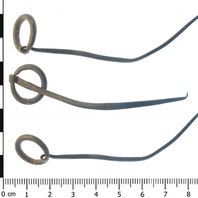
Viking Objects
Ring-Headed Pin (SWYOR-E57351)
The ringed pin was a form of dress fastener which developed as a result of contact between artisans in the Celtic West and sub-Roman Britain. The type became very popular in Ireland, being ultimately adopted by the Hiberno-Norse during the Viking period. In form it comprised a pin with a ring inserted through a looped, perforated or pierced head.
Read More
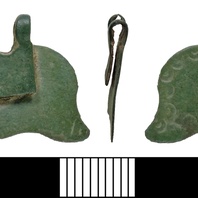
Viking Objects
Fish-Tail Pendant (DENO-08A172)
This copper-alloy pendant is in the shape of a symmetrical fish-tail decorated with a ring-and-dot motif around the edge. While the reverse of this object has traces of a silver coating, the front does not, which likely means that the silver coating represents solder used to keep the folded-over loops attached. For more information on Scandinavian jewellery in England check out our blog: Brooches, Pendants and Pins: Scandinavian Dress Accessories in England.
Read More
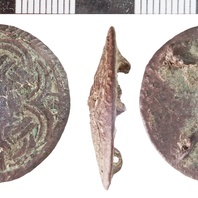
Viking Objects
Gilded Disc Brooch (NLM-783BCB)
This brooch is classed as Weetch Type 4 and resembles Viking-Age Terslev-style brooches. It is decorated with interlaced double strapwork and a cabled border and retains some traces of gilding. For more information on Scandinavian jewellery in England check out our blog: Brooches, Pendants and Pins: Scandinavian Dress Accessories in England.
Read More
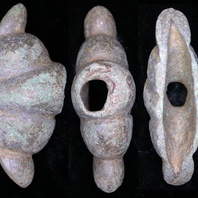
Viking Objects
Sword Pommel (LEIC-6D2448)
This copper-alloy sword pommel is made up of five lobes and is classed as a Petersen L type VI. Sword pommels were used to counter balance a sword as well as provide a decorative feature. In many cases they are the only method of identifying sword typologies.
Read More
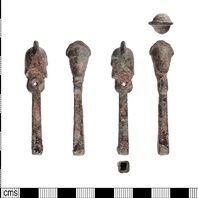
Viking Objects
Copper-Alloy Toilet Implement (LIN-756E6A)
This early medieval socketed anthropomorphic object possibly depicts the Norse god Odin, who wears a bird-headed helmet or headdress. This object belongs to a group of similar figurines, all with bird-headed helmets or headdresses, which have been found in England, Sweden, Gotland, Denmark, Russia, and Belgium. Evidence from cemeteries demonstrates this type of object is strongly associated with women, and is probably an import from Sweden dating to the later seventh century, demonstrating contacts with Scandinavia before the Viking Age. While the exact function of this object remains unclear, parallels suggest it is perhaps a toilet implement.
Read More
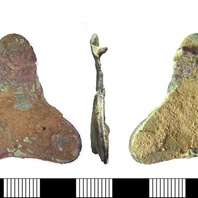
Item
Trefoil Brooch (LEIC-BD8163)
Trefoil brooches were characteristically Scandinavian women’s wear. However, many examples found in the East Midlands were probably made in the Danelaw, and may have been copies of Scandinavian styles, instead of being imported from Scandinavia. The decoration on this example features a foliate design. For more information on Scandinavian jewellery in England check out our blog: Brooches, Pendants and Pins: Scandinavian Dress Accessories in England.
Read More
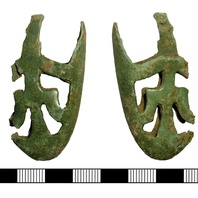
Viking Objects
Scabbard Chape (NLM-5BD697)
The incomplete openwork tongue-shaped front plate of this chape is decorated with at least six asymmetrical apertures and resembles similar chapes with ‘Birka Falcon’ decoration.
Read More
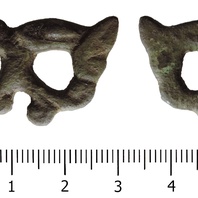
Viking Objects
Zoomorphic Mount (DENO-7E523C)
This example of a copper-alloy openwork zoomorphic mount, strap fitting or harness fitting, is decorated with the head of an animal in profile.
Read More
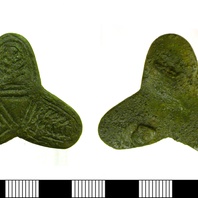
Viking Objects
Trefoil Brooch (LEIC-A43E83)
Trefoil brooches were characteristically Scandinavian women’s wear. However, many examples found in the East Midlands were probably made in the Danelaw, and may have been copies of Scandinavian styles, instead of being imported from Scandinavia. This example was found near Lincoln. For more information on Scandinavian jewellery in England check out our blog: Brooches, Pendants and Pins: Scandinavian Dress Accessories in England.
Read More
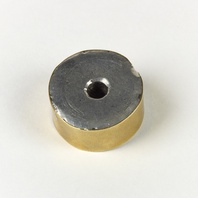
Viking Objects
Reproduction Copper Alloy-Edged Lead Weight
A lead weight edged with a copper alloy band.
Read More
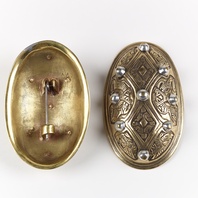
Viking Objects
Reproduction Oval Brooches
Oval brooches were used to fasten dresses in the Viking Age. They are diagnostically Scandinavian and indicate a Scandinavian identity wherever they are found. This pair of brooches is a reproduction of a pair found at Adwick le Street near Doncaster. The mismatched pair were buried with a Norwegian woman who died within a generation of the arrival of the Great Army in the mid-ninth century. Scandinavian brooches came in a variety of sizes and shapes which included disc, trefoil, lozenge, equal-armed, and oval shapes. The different brooch types served a variety of functions in Scandinavian female dress with oval brooches typically being used as shoulder clasps for apron-type dresses and the rest being used to secure an outer garment to an inner shift. Anglo-Saxon brooches do not match this diversity of form with large disc brooches being typical of ninth century dress styles with smaller ones becoming more popular in the later ninth and tenth centuries. However, since disc brooches were used by both Anglo-Saxon and Scandinavian women they are distinguished by their morphology. Scandinavian brooches were typically domed with a hollow back while Anglo-Saxon brooches were usually flat. Moreover, Anglo-Saxon brooches were worn singly without accompanying accessories.
